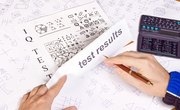The Cognitive Ability Test (CogAT) is a widely used test used to measure students reasoning and problem solving skills. The test is divided into three sections called batteries; verbal, quantitative and non-verbal, and students may be given the whole test or individual batteries. The non-verbal section focuses on images and geometric shapes.
Non-Verbal Battery
The non-verbal battery in the CogAT can be the area of the test that is most challenging to children, as they are a type of test not normally experienced in formal schooling. However, as they contain no reading at all, they are a suitable way to assess skills in students with linguistic problems -- dyslexia, for example, or English as a second language -- or disadvantages caused by a lack of exposure to numbers, writing and reading. There are three parts in the non-verbal battery; students are given 10 minutes for each part.
Figure Classification
In the figure classification section, sets of pictures are shown to children, a group of three things that have something in common; three different vegetables or flowers, for example. They will also have individual pictures to choose from, and they have to decide which picture falls into the same category as the three initially provided. The test focuses on classifications. This part of the test asks the student to find similarities in the question set, and then find a further similarity in the offered set of answer pictures.
Figure Analogies
In the analogy section, the student will be asked to use the relationship between two figures to infer a second pairing. There are three images; one will be a pair and they will have to find the partner for the third from the answer choices. A simple question might show a blank triangle paired with a shaded-in triangle, and give a blank square as the third image. The answer would be the shaded-in square.
Figure Analysis
Figure analysis assesses spatial awareness, and analysis of figures and diagrams. A question would show diagrams, for example, of a piece of paper being folded and having a hole punched into the folded corners. The answer choices would include a picture of how the paper would look once unfolded. Students are required to analyze the end result of a series of diagrams.
Related Articles
References
Writer Bio
Louise Jones has been a technical writer since 2006 and is the director of a technical writing company, providing literature for U.K. construction firms such as MITIE and Balfour Beatty. Her work also appears on various websites, focusing on business and technical articles. Jones has a postgraduate certificate in education and has been trained in information technology. She studied English at Cambridge University.











